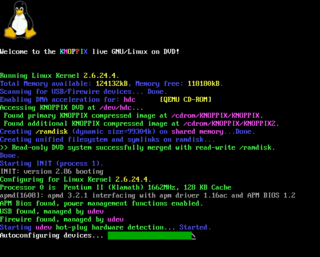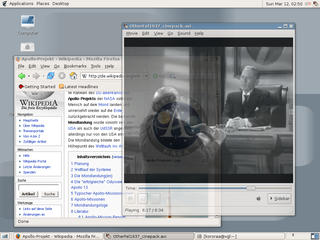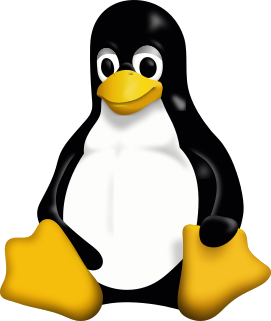
The Linux framebuffer (fbdev) is a graphic hardware-independent abstraction layer to show graphics on a computer monitor, typically on the console. The word framebuffer means a part of video memory containing a current video frame, and the Linux framebuffer means “access method to the framebuffer under the Linux kernel”, without relying on system-specific libraries such as SVGALib or another user space software.
Radeon is a brand of computer products, including graphics processing units, random-access memory, RAM disk software, and solid-state drives, produced by Radeon Technologies Group, a division of Advanced Micro Devices. The brand was launched in 2000 by ATI Technologies, which was acquired by AMD in 2006 for 5.4 billion USD.
DirectFB is a software library with a small memory footprint that provides graphics acceleration, input device handling and abstraction layer, and integrated windowing system with support for translucent windows and multiple display layers on top of the Linux framebuffer without requiring any kernel modifications. DirectFB is free and open-source software subject to the terms of the GNU Lesser General Public License (LGPL).
Video4Linux, V4L for short, is a collection of device drivers and an API for supporting realtime video capture on Linux systems. It supports many USB webcams, TV tuners, and related devices, standardizing their output, so programmers can easily add video support to their applications. MythTV, tvtime and TVHeadend are typical applications that use the V4L framework.
Direct3D and OpenGL are competing application programming interfaces (APIs) which can be used in applications to render 2D and 3D computer graphics. Hardware acceleration of this process has been commonplace since approximately 1999. As of 2005, graphics processing units (GPUs) almost always implement one version of both of these APIs. Examples include: DirectX 9 and OpenGL 2 circa 2004; DirectX 10 and OpenGL 3 circa 2008; and most recently, DirectX 11 and OpenGL 4 circa 2011. GPUs that support more recent versions of the standards are backward-compatible with applications that use the older standards; for example, one can run older DirectX 9 games on a more recent DirectX 11-certified GPU.
Mesa, also called Mesa3D and The Mesa 3D Graphics Library, is an open source software implementation of OpenGL, Vulkan, and other graphics API specifications. Mesa translates these specifications to vendor-specific graphics hardware drivers.

Xgl is an obsolete display server implementation supporting the X Window System protocol designed to take advantage of modern graphics cards via their OpenGL drivers, layered on top of OpenGL. It supports hardware acceleration of all X, OpenGL and XVideo applications and graphical effects by a compositing window manager such as Compiz or Beryl. The project was started by David Reveman of Novell and first released on January 2, 2006. It was removed from the X.org server in favor of AIGLX on June 12, 2008.

Brian E. Paul is a computer programmer who originally wrote and maintained the source code for the open source Mesa graphics library until 2012 and is still active in the project. Paul began programming initial source code in August 1993. Mesa is a free software/open source graphics library that provides a generic OpenGL implementation for rendering three-dimensional graphics on multiple platforms. Though Mesa is not an officially licensed OpenGL implementation, the structure, syntax and semantics of the API is that of OpenGL.

The Linux kernel provides several interfaces to user-space applications that are used for different purposes and that have different properties by design. There are two types of application programming interface (API) in the Linux kernel that are not to be confused: the "kernel–user space" API and the "kernel internal" API.

A free and open-source graphics device driver is a software stack which controls computer-graphics hardware and supports graphics-rendering application programming interfaces (APIs) and is released under a free and open-source software license. Graphics device drivers are written for specific hardware to work within a specific operating system kernel and to support a range of APIs used by applications to access the graphics hardware. They may also control output to the display if the display driver is part of the graphics hardware. Most free and open-source graphics device drivers are developed by the Mesa project. The driver is made up of a compiler, a rendering API, and software which manages access to the graphics hardware.

Accelerated Indirect GLX ("AIGLX") is an open source project founded by Red Hat and the Fedora community, led by Kristian Høgsberg, to allow accelerated indirect GLX rendering capabilities to the X.Org Server and DRI drivers. This allows remote X clients to get fully hardware accelerated rendering over the GLX protocol; coincidentally, this development was required for OpenGL compositing window managers to function with hardware acceleration.
VirtualGL is an open source program that redirects the 3D rendering commands from Unix and Linux OpenGL applications to 3D accelerator hardware in a dedicated server and displays the rendered output interactively to a thin client located elsewhere on the network.
The graphics address remapping table (GART) or graphics aperture remapping table (GART), sometimes also graphics translation table (GTT), is an I/O memory management unit (IOMMU) used by Accelerated Graphics Port (AGP) and PCI Express (PCIe) graphics cards. The GART allows the graphics card direct memory access (DMA) to the host system memory, through which buffers of textures, polygon meshes and other data are loaded. AMD later reused the same mechanism for I/O virtualization with other peripherals including disk controllers and network adapters.
MiniGLX is a specification for an application programming interface which facilitates OpenGL rendering on systems without windowing systems, e.g. Linux without an X Window System or embedded systems without a windowing system. The interface is a subset of the GLX interface, plus a minimal set of Xlib-like functions.

nouveau is a free and open-source graphics device driver for Nvidia video cards and the Tegra family of SoCs written by independent software engineers, with minor help from Nvidia employees.

AMD Radeon Software is a device driver and utility software package for Advanced Micro Devices's graphics cards and APUs. It is built using the Qt toolkit and runs on Microsoft Windows and Linux, 32- and 64-bit x86 processors.

EGL is an interface between Khronos rendering APIs and the underlying native platform windowing system. EGL handles graphics context management, surface/buffer binding, rendering synchronization, and enables "high-performance, accelerated, mixed-mode 2D and 3D rendering using other Khronos APIs." EGL is managed by the non-profit technology consortium Khronos Group.


















